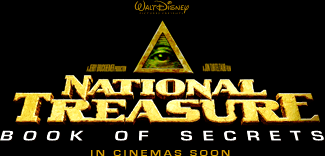
When Hollywood comes knocking, that's probably a clue the time has come to open the door. And the secretive, centuries-old order of Freemasonry seems to be picking up its cue.
"National Treasure: Book of Secrets," which opened in theaters this weekend, is the second film in the adventure-fantasy series to shine a light on the mysterious and little-known world of the Masonic order.
And although the Masons play a much smaller part in the sequel than they did in the 2004 original, the first scene featuring the movie's three male leads -- Nicolas Cage, Jon Voight and Ed Harris -- was filmed in Alexandria's George Washington Masonic Memorial, one of the Masons' most visible shrines.Filmmakers and novelists have been mining the Masons recently, weaving their legends and symbols into such tales of conspiracies and secrets as the "National Treasure" films and Dan Brown's "The Da Vinci Code." And filmmakers' interest comes as the fraternal, often-controversial Freemasons pull back the curtain on themselves in an effort to update their antiquated image and replenish their dwindling ranks.
Director Jon Turteltaub says, "The 'National Treasure' movies are all about things we think are forgotten but are actually pieces of history that are still percolating around us and have a role in our current lives -- a lot like the Masons.
"Footage was shot at some of the grandest buildings in the Washington area -- the Library of Congress, the Lincoln Memorial and Mount Vernon -- for the sequel. (The Oval Office was a constructed set.) But filming also took place in the Masonic Memorial, known locally as the Masonic Temple, the Masons' majestic hilltop shrine to their most prominent member, George Washington. The top of the temple reaches to 400 feet above sea level, one of the highest points in the Washington area.
Although the Masonic Temple is Alexandria's most visible landmark -- and one of Washington's most intriguing and grandiose shrines -- few Washingtonians know what goes on inside the ornate building or what the organization behind it is all about. For centuries, the all-male group's eerie symbols and the exotic costumes have provoked speculation about the possibly strange doings inside their temples.
In the film, the Masonic Temple's grand auditorium acts as a stand-in for a lecture hall. Other than providing what the director called a "gorgeous, extraordinary" set, the Masons figure little in the sequel -- but their small part is significant. In a surprising twist, it turns out that the character Sadusky (Harvey Keitel), a Mason, is a better man than he seemed in the first film.
"When people don't know an organization, they fear it," says George Seghers, executive director of the Masonic Memorial. "If people don't know what you're doing, they think the worst.
"But Seghers -- and other prominent Masons -- are determined to change that. And being in a Hollywood movie is just a small part of that effort.
"We're really trying to bring the memorial back into the community, not just be a fortress on the hill," Seghers says. "We're nothing to be afraid of.
"Masons say their organization is dedicated to "making good men better." It donates about $2.5 million a day to medical research, health care, education and other causes, according to Richard Fletcher, a spokesman for the group. Masons are a staple of community parades, where they dress as clowns and ride in little cars to raise money for Shriners' hospitals.
Fletcher says the Masons numbered 1.5 million in 2006, down from a peak of 4 million in 1959. He says the membership shrank rapidly as the World War II generation, which he described as a generation of joiners, has continued to age and die.
But now there's a feeling in the group -- not yet backed up by statistics -- that the tide has turned and that a new generation is "looking for something beyond themselves, an anchor to stabilize their lives," Fletcher says. He says younger men nowadays are part of a "generation of volunteers," which he predicts will stabilize the downturn.
Others aren't as optimistic."The lodges are in deep decline," says UCLA historian Margaret Jacob, author of "The Origins of Freemasonry: Facts & Fictions" and an expert in Masonic history. "It's no longer a vital societal organization, so it has become the subject of myth and legend.
"One prominent local Mason today is Stephen Trachtenberg, former president of
